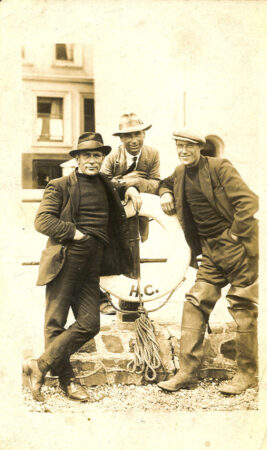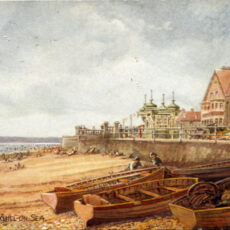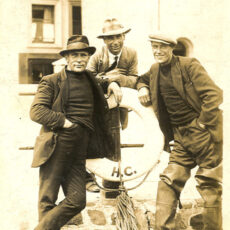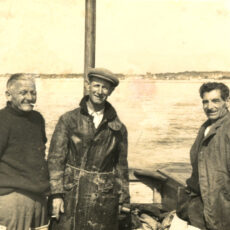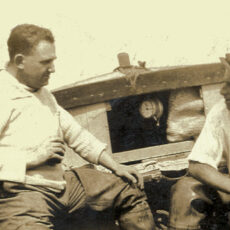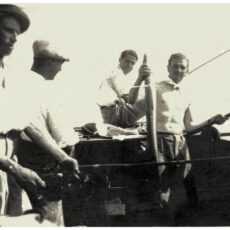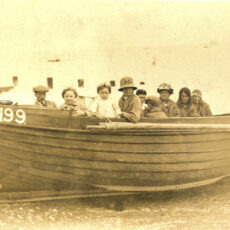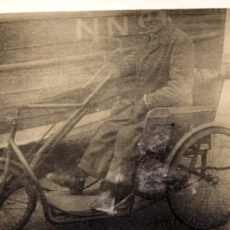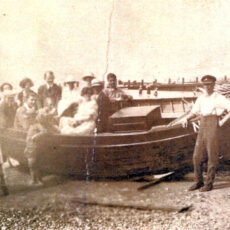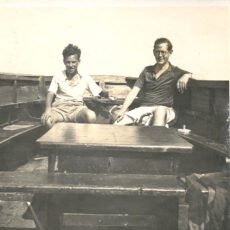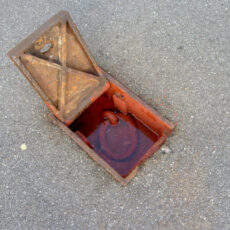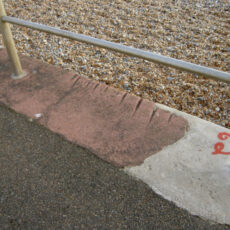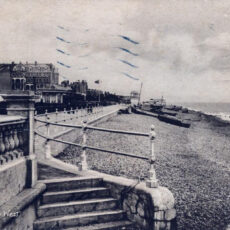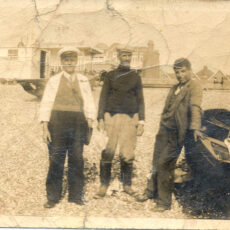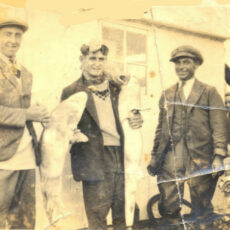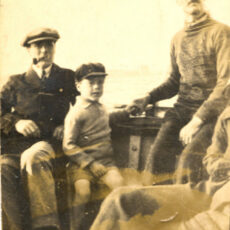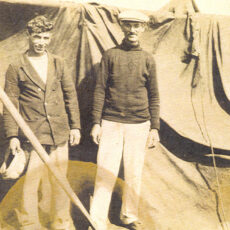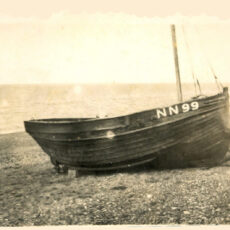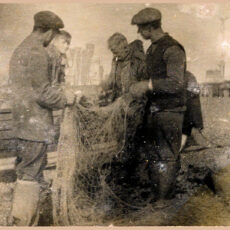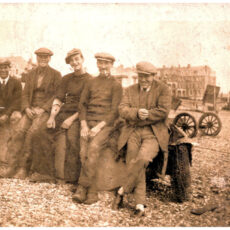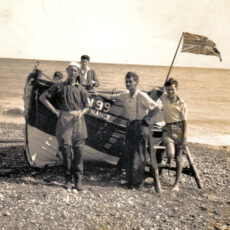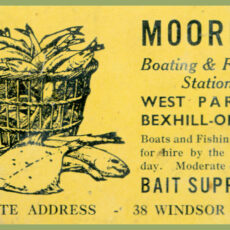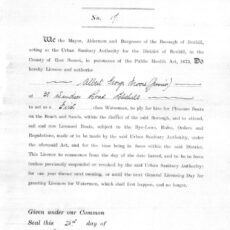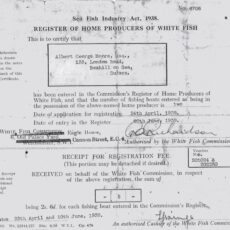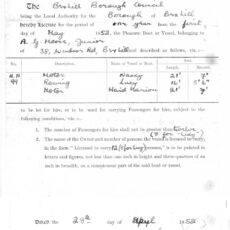The following is the story of the man and the fishing industry he founded, in Bexhill, in the early 1900s.
It closed in the 1950s purely because there was no one willing to carry on the business. Over the years that followed, the fact that this business had ever existed was forgotten until a descendant of the man who started it began looking into his family history. Bexhill Museum, in 2007, put on an exhibition on the subject and the images are those used at the time. Unfortunately, the quality of the photographs is far from perfect, due to time, but, none-the-less, they are, perhaps, the only record of a man and his business.
Fishing in Bexhill
Fishing has never been as important to Bexhill as it has been to neighbouring towns such as Hastings and Rye. In its heyday in the 1850s and 1860s, the Hastings fishing fleet boasted over 20 large craft, called “luggers”, which were up to 55 feet long, plus smaller boats.
However, there was some fishing in Bexhill, notably run from Moore’s Boating & Fishing Station on the West Parade.
A. G. Moore & Sons Boating & Fishing Station
Albert Moore, originally from Hooe, near Battle, founded the company and was later joined by his sons Albert, Joe, Roland and “Jacko”, plus employees such as Fred Hunnisett and Frank Packham. The company was started in the early 20th century and ceased trading in about 1955, having continued throughout World War II.
Moore’s boats carried the “NN” registration, which is for Newhaven district, or the RX registration for the Rye district.
They first had small unregistered boats. In 1919, their first recorded boat was acquired, the RX285 “Our Boys”, a sailing lugger. The next major acquisition was the NN99 “Nancy” in 1921; she was used for fishing and for pleasure trips in the summer months.
The lugger “May Queen” was added in 1921, followed by “Roland”, a large rowing boat with an outboard engine which was largely used for long line fishing and later for leisure fishing. Other boats included the “Dennis”, “Adventure” and “Lucy”.
The Fishing Station was located on West Parade and can be seen in the background of some of the photographs. Boats were winched up the beach and anchored via “frapping points” set into the promenade. Grooves on the edge of the sea wall indicate where winch cables would have been located. During World War II, the fleet was moved down to the East Parade.
The fish caught by Moore’s supplied local fish shops, hotels and schools, and a handcart took fish around to residents. In 1917, there were seven fishmongers in the town.
Moore’s offered pleasure trips and took boats out to destinations such as Beachy Head and Fairlight. Sea anglers were also catered for and notable customers included John Sainsbury, the founder of the supermarket chain who lived in Little Common, and Hartley Shawcross, a lawyer involved in the Nuremburg War Trials after World War II.
In 2007, David Moore, the grandson of Albert Moore, after carrying out a great deal of research on his family, arranged a get-together of as many descendants as he could. John Dowling reported the coming of this get-together, in the “Bexhill Observer”, of January 2nd, 2007.
First, John Dowling’s pre-event article, in the Observer, and then, the up-date:-
Visual reminders of a lost industry by John Dowling
A promenade device looking like a hydrant cover and a few grooves in the sea wall are the only visual reminders of a lost Bexhill industry. But soon that will change. A year’s diligent research into the former family fishing business of A. G. Moore and Sons has led Dave Moore, 70, with a treasure trove of local history.
The search has taken him through the family files and the county archive office. Now his work is about to have a practical outcome. An exhibition dedicated to the family firm is about to open at Bexhill Museum. By May, Dave hopes to have the commemorative phosphor bronze plaque that he has had made mounted and dedicated on West Parade where his grand-father’s fleet of boats were once kept.
A painting by local artist Colin Tapp and commissioned by Dave now depicts the beach scene in the Fifties shortly before the firm ceased fishing. Dave’s research was prompted by the death of his mother, Joan, a year ago. It has brought back happy boyhood memories. After service in the Merchant Navy, Dave became a salesman. But, as he recalled for the Observer, his first successful sale came at the age of about 10 – when two pints of shrimps cost three shillings.
“The firm was founded by my grandfather, Albert Moore. He was born at Hooe. He was a thatcher and ditcher. He used to supplement his living doing beach and groyne work at Normans Bay and Pevensey – walking distance because they had no transport then. He got a bit of a liking for the sea. He moved to North Road (now London Road), Bexhill.”
According to the pages of the archives at Lewes, he had two boats, the May Queen and Our Boys at Bexhill in 1917, both luggers of about three or four tons. Though under strict military control, as the Great War raged, the firm became established.
“Later, they got the Swallow. That was about 30 tons but it was too big for Bexhill beach and they sold it. He gradually extended his business to include sailing luggers and then had sailing boats for fishing. There must have been quite a fleet down there. They had the Nancy -.that was a big favourite in the family -Roland, Dennis, Adventure, Lucy… “
Albert had been joined in the business by his sons – Albert George (the eldest), Joe, Roland and Dave’s father “Jacko” who was the youngest. Later they were joined by faithful employees like Fred Hunnisett and Frank Packham. The inter-war years were good for the firm. The fleet’s catch was sold entirely in the town. It was as well that in A.G. Moore’s heyday catches were good. These were the halcyon years of the hotels industry in the town and, that other pillar of the local economy, the many independent schools. Local fish shops also abounded. A. G. Moore’s handcart plied a busy trade around Bexhill. Albert Moore’s fleet came under strict military control once more during the Second World War. The site was moved for the duration to where the Sailing Club now stands. A double “wall” of barbed wire entanglements lined the beach with a minefield between the two. Albert’s boats were at the only access point to the beach. Albert and his sons had to wait until a sentry opened the way through the beach defences.
Once they didn’t wait.. “I remember my father telling me. The sentry wasn’t on duty to open up for them. Grandfather said ‘I can’t wait. We’ll miss the tide..’ So, he opened up on his own and off they went fishing.”
“When they got back, the military were waiting for them. Granddad was arrested and taken up to Hastings Road (where private schools had been requisitioned by the Army). They told him he would be court-martialled for ‘cutting’ the nation’s de-fences. Nothing ever came of it. I expect a bath of fish changed hands and they had a drink on it…”
The war years brought many scrapes. “They trawled up a mine. One time they brought back part of a Doodlebug (V1 flying bomb) but the military told them it was ‘fairly safe’! They sold a lot of fish to the military. They were all over town in the schools. There were lots of Canadians.” The sea dominated Dave’s child-hood. “Whoever said ‘happy as a sand-boy’ was right. My cousin Albert and I would go shrimping and prawning. We’d dig for lug-worm – the firm’s long-lines were couple of miles long and took a tidy bit of bait.”
“We lived in Prospect Cottages in Belle Hill. My mother would boil the shrimps. There were always blocks of Stag salt to put in with them. Three minutes and they were done. They were laid out on the table – wooden of course – to dry.”
“Then I would go off selling them. I had quite a round of regular customers in Belle Hill and Amherst Road.”
The brief post-war seaside holiday boom saw the firm taking boar-loads of amateur anglers out to sea.
Pleasure trips took A.G. Moore’s craft out to the Royal Sovereign Lightship, to Beachy Head and Fairlight. Customers on the sea angling trips included Nuremberg War Trials advocate Hartley Shawcross while holidaying in Bexhill.
Distinguished Little Common resident J.B. Sainsbury was a regular. “He always brought the hamper. The proverbial bottle of scotch, the beer and – of course – Sainsbury’s ‘Grosvenor’ pies.”
Getting a boat ashore on a shelving shingle beach like Bexhill’s is never easy. Incredibly, the firm’s winch cables stretched ACROSS West Parade in the early days – until the council tired of the firm using trees where Alderton Court flats were later built as anchor points. Dave points with pride to the two remaining promenade symbols of an era which ended when A.G. Moore ceased trading in about 1955.
Despite having grandsons Dennis, George, Peter, John, Albert and David none was interested in fishing for a living. “Uncle Francis had been killed in the war. He was in the navy and went down with the Jervis Bay when the plucky armed merchantman took on the pocket battleship, Admiral Scheer, to save her convoy.
Dave lifts that “hydrant” cover to reveal a rusty iron ring. “That’s the old frapping point – the anchor for the winch cable. Those grooves in the sea wall are witness to years of toil when the cables winched the busy fishing fleet ashore. At first it was done by hand. Somewhere in the Thirties or Forties they acquired a motor. It was incredibly old, out of a Morris Cowley. It would chug away and haul the boats. It’s still buried in the shingle somewhere…”
That is the end of John Dowling’s article and what follows is the update of 25th June 2007
Moore family gather for unique event
MORE than 40 members of the Moore family – some from as far as Scotland – have gathered for a unique commemoration. They were standing on the site from which the family firm operated a fishing and pleasure boat fleet for more than 50 years.
A significant piece of Bexhill history was commemorated when Town Mayor Cllr Paul Lendon, who leads town history walks, unveiled a plaque marking the contribution made to the town by A.G. Moore and Sons.
For David Moore, last Thursday’s ceremony was the climax of a year’s painstaking research which took him not only through the family archives but those at Lewes record office.
From 1906 to 1960 Dave’s grandfather, Albert Moore, his father, uncles and cousins ran a fleet of boats which supplied Bexhill.
The bronze plaque has been set into the promenade next to the firm’s “frapping point”, the anchorage from which the boats were winched up the beach and on to the promenade in bad weather.
For years the huge iron ring had been hidden by a cast metal cover. Now a thick glass plate gives passers-by a glimpse of Bexhill’s past. Before the flag of St George was removed from the plaque by Dave Moore and his first cousin, Albert, the Town Mayor recounted how the firm’s founder had walked daily from Hooe to work on Bexhill’s beach defences.
He had bought a boat and augmented his income by fishing. As his family grew, he bought more boats – and named them after family members. The firm not only supplied Bexhill with fish but in the years of peace gave enjoyment to residents and holidaymakers alike with pleasure trips. The family maintained their supply of fishing despite the dangers of two world wars – feeding not only the town’s civilian population but the many troops billeted in Bexhill.
The plaque was blessed by the Rev Olivia Werrett.
The large group of family and friends gathered on the promenade joined in prayer not only in recognition of the hard work, dedication and courage shown by a previous generation but for the physical safety and spiritual welfare of those who still put to sea to fish.
The Moore family’s contribution to Bexhill’s past is commemorated in a museum exhibition featuring archive photographs and a painting by Colin Tapp depicting the between-the-wars beach scene.
Museum curator Julian Porter and Rother chief executive Derek Stevens, who is also clerk to Bexhill’s Charter Trustees, were among guests at the ceremony which concluded with clarinet solos by Terry Giles of Creole Jazz.
Photo Gallery
The following photographs are presented in galleries of four images which allows for descriptions to be easily identified with the appropriate image.
Gallery 1
MFS-001 – Postcard of West Parade showing the Boating and Fishing Station in 1920
MFS-002 – Albert Moore junior (centre) in Hastings in 1926
MFS-003 – The earliest photograph of the fishing industry c. 1914 with Albert Moore senior (centre)
MFS-004 – The crew at sea in 1949. Left to right: Frank Packham (foreground), Albert Armstrong and Albert Moore junior
MFS-005 – At sea c. 1948, Fred Hunnisett on the right
Gallery 2
MFS-006 – At sea c. 1948, Fred Hunnisett on the left
MFS-007 – The “Nancy” with holiday-makers in the late 1930s, showing Albert Moore far left and “Cousin Joe” far right
MFS-008 – John Stevens in front of one of the Moore’s boats
MFS-009 – The “Nancy” with passengers at the Boating and Fishing Station in 1919. Albert Moore is on the far right
MFS-010 – Moore19 – Summer visitors, Mr Piggott and his son, on one of the Moores’ boats in the late 1940s to 50s
Gallery 3
MFS-011 – Boats were anchored via “frapping points” set into the promenade
MFS-012 – Grooves on the edge of the sea wall indicate where winch cables were located
MFS-013 – West Beach Postcard – Postcard from 1920, showing fishing boats on the West Beach
MFS-014 – This shows the fishing hut in the background to the left, with (from left to right), a deckchair attendant, Albert Moore Senior and Albert Moore Junior, in 1935
MFS-015 – Leisure fisherman, with Albert Moore Junior on the right, outside the fishing hut, c. 1930
Gallery 4
MFS-016 – A leisure trip in 1930, with Albert Moore senior on the right, and possibly John Sainsbury on the left
MFS-017 – Taken in 1919, Albert Moore, father and son
MFS-018 – The “Nancy” after alterations to build up the gunwales
MFS-019 – Checking the nets in 1950: from left to right Fred Hunnisett, unknown boy, Albert Armstrong & Frank Patcham
Taking a break on the beach, c. 1928, with Albert Moore senior second from the right
Gallery 5
MFS-021 – The “Nancy” and crew c. 1949-50. Front row left to right: Frank Packham, unknown boy, Albert George Moore junior, and the son of Mr Piggott, a summer visitor
MFS-022 – Advertising card for “Moore’s Boating & Fishing Station”
MFS-023 – Waterman’s Licence – No. 17 (Borough of Bexhill), dated 26th April 1939. Albert George Moore (junior) of 38, Windsor Roa, Bexhill. To act as First Class Waterman.
MFS-024 – “Sea Fish Industry Act 1938”. Register of Home Producers of White Fish – Albert George Moore, Esq., 133, London Road, Bexhill-on-Sea. The registration fee was 5/- (being 2/6d for each of his two boats. Payment received by the White Fish Commission. The application was made on 24th April, 1939 and entered in the Register on 20th June 1939.
MFS-025 – “Public Health Acts Amendment Act, 1907”, “Licence for Pleasure Boats and Vessels” Albert obtained a licence for three boats


